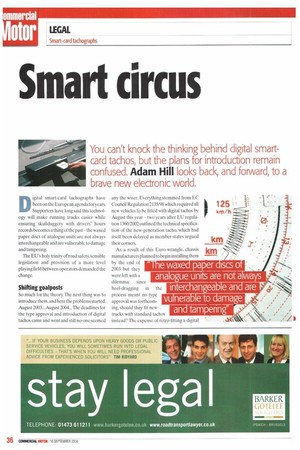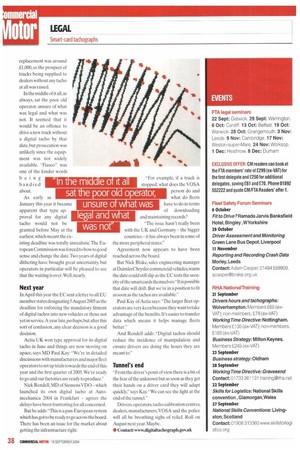Smart circus
Page 38

Page 40

If you've noticed an error in this article please click here to report it so we can fix it.
You can't knock the thinking behind digital smart card tachos, but the plans for introduction remain
confused. Adam Hill looks back, and forward, to a
brave new electronic world.
Digital smart-card tachographs have been on the European agenda for years. Supporters have long said this technology will make running trucks easier while ensuring skullduggery with drivers' hours records becomes a thing of the pastthe waxed paper discs of analogue units are not always interchangeable and are vulnerable to damage and tampering.
The EU's holy trinity of road safety, sensible legislation and provision of a more level playing field between operators demanded the change.
Shifting goalposts So much for the theory. The next thing was to introduce them, and here the problems started. August 2003...August 2004...The deadlines for the type approval and introduction of digital tachos came and went and still no-one seemed any the wiser. Everything stemmed from EC Council Regulation 2135/98 which required all new vehicles to be fitted with digital tachos by August this year two years after EU regulation 1360/2002 outlined the technical specification of the new-generation tacho, which had itself been delayed as member states argued their corners.
As a result of this Euro-wrangle, chassis manufacturers planned to begin installing them by the end of 2003 but they were left with a dilemma: since heel-dragging in the process meant no type approval was forthcoming, should they fit new trucks with standard tachos instead? The expense of retro-fitting a digital replacement was around £1,000, so the prospect of trucks being supplied to dealers without any tacho at all was raised.
In the middle of it all, as always, sat the poor old operator, unsure of what was legal and what was not. It seemed that it would he an offence to drive a new truck without a digital tacho by that date, but prosecution was unlikely since the equipment was not widely available. "Fiasco" was one of the kinder words being bandied about.
As early as January this year it became apparent that type approval for any digital tacho would not be granted before May at the earliest, which meant the existing deadline was totally unrealistic. The European Commission was forced to bow to good sense and change the date.Two years of digital dithering have brought great uncertainty, but operators in particular will be pleased to see that the waiting is over, Well, nearly.
Next year
In April this year the EC sent a letter to all EU member states designating 5 August 2005 as the deadline for enforcing the mandatory fitment of digital tachos into new vehicles or those not yet in service.A year late, perhaps, but after this sort of confusion, any clear decision is a good decision.
Actia UK won type approval for its digital tacho in June and things are now moving on apace, says MD Paul Kay: -We're in detailed discussions with manufacturers and major fleet operators to set up trials towards the end of this year and the first quarter of 2005. We're ready to go and our factories are ready to produce."
Nick Rendell, MD of Siemens 'VDO which launched its own digital tacho at Automechanica 2004 in Frankfurt agrees the delays have been frustrating for all concerned.
But he adds: "This is a pan-European system which has got to be ready to go across the board. There has been an issue for the market about getting the infrastructure right. "For example, if a truck is stopped, what does the VOSA person do and what do fleets have to do in terms of downloading and maintaining records?
"The issue hasn't really been with the UK and Germany the bigger countries-it has always been in some of the more peripheral states."
Agreement now appears to have been reached across the board.
But Nick Blake, sales engineering manager at DaimlerChrysler conunercial vehicles, warns the date could still slip as the EC tests the security of the smart cards themselves: "It is possible that date will drift. But we're in a position to fit as soon as the tachos are available."
Paul Kay of Actia says: "The larger fleet operators are very keen because they want to take advantage of the benefits It's easier to transfer data which means it helps manage fleets better."
And Rendell adds: -Digital tachos should reduce the incidence of manipulation and ensure drivers are doing the hours they are meant to."
Tunnel's end
"From the driver's point of view there is a bit of the fear of the unknown but as soon as they get their hands on a driver card they will adapt quickly," says Kay. "We can see the light at the end of the tunnel."
Drivers, operators, tacho calibration centres, dealers, manufacturers,VOSA and the police will all be breathing sighs of relief. Roll on August next year. Maybe.
• Contact: www.digitaltachograph.gov.uk






































































































































































































